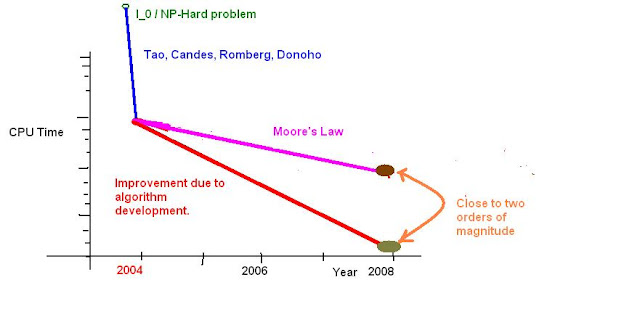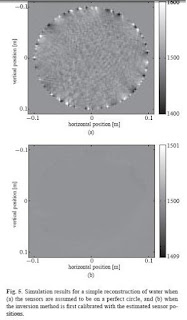[ I am still looking for the most interesting paper on Compressive Sensing you read in 2010 ? You can remain anonymous, just the title is enough, no need for full references.]
After the 2008 version, the 2009 version, here is the 2010 version of the Thank You Post. All of you listed below have one thing in common, you know about Nuit Blanche and had some sorts of a conversation on it this past year. Make no mistake, these conversation may have been short, but they helped somebody else. I am done with the introduction bit, now talk amongst yourselves :-). Sorry for the ones I missed, but here is the list in no particular order:
- Piotr Indyk
- Yaniv Erlich
- David Miraut Andres
- Anders Hansen
- Meena Mani
- Laurent Duval
- Alex Dimakis
- Yonina Eldar
- Dick Gordon
- Dror Baron
- Christy Fernandez-Cull
- Lianlin Li
- Ray Maleh
- Sarah
- Emil Sidky
- Justin Romberg
- Eric Trammel
- Mehmet Akackaya
- Larry Wasserman
- Amit Ashok
- Gabriel Peyré
- Stefano Marchesini
- Zainul Charbiwala
- Esther Rodriguez-Villegas
- Jort Gemmeke
- Moshiko Mishali
- Laurent Daudet
- Sungkwang Mun
- Kayhan Batmanghelich
- Raghu Kainkaryam
- Sylvain Gigan
- Stephen Becker
- Mingyan Liu
- Tony Vladusich
- Emmanuel Candes
- Yves Wiaux
- Olivier Grisel
- Emily Allstot
- Laurent Jacques
- Jong Chul Ye
- Emil Sidky
- Pierre Vandergheynst
- Ronan Le Boulch
- Daniel Reetz
- Stephen Becker
- Yilun Wang
- Laurent Duval
- Prasad Sudhakar
- Mahesh Shastry
- Michael Wakin
- Stefan Schiffer
- Yihong Wu
- Jared Tanner
- Remi Gribonval
- Rick Trebino
- Danny Bickson
- Volkan Cevher
- Zac Harmany
- Felix Herrmann
- Waheed Bajwa
- Emil Sidky
- Amit Ashok
- Sungkwang Mun
- Kfir Gedalyahu
- Ronen Tur
- Jalal Fadili
- Atul Divekar
- Kayhan Batmanghelich
- Stefano Marchesini
- Robert
- Mike Davies
- Giuseppe Paleologo
- Alessandro Foi
- Chinmay Hegde
- Yannis Kopsinis
- Jeff Blanchard
- Junfeng Yang
- Sergey Ten
- Marco Duarte
- Muthu Muthukrishnan
- Jim Fowler
- Phil Schniter
- Harry Sun and Yi (Jessica) Yao
- Hosein Mohimani
- Khoa Luu
- Ramesh Raskar
- Angshul Majumdar
- Bob Sturm
- Jordan Ellenberg
- Laura Balzano
- Julien Mairal
- Jarvis Haupt
- Jason Kridner
This past year has also seen a rise of websites linking to the blog, I have bestowed the honor of having Good Taste in All Manners to all the following blogs/websites:
- http://www4.ncsu.edu/~jtan
- http://www.ece.msstate.edu/~ewt16
- http://www.cse.unsw.edu.au/~wenh/wen_hu/Media.html
- http://www-stat.stanford.edu/~markad/links
- http://www.ics.uci.edu/~rmorshed/links.htm
- http://fastmri.org/links
- http://staff.washington.edu/mounce
- http://ee.sharif.ir/~zayyani/Links.html
- http://www.ece.mcgill.ca/~shamid4/Links.html
- http://people.engr.ncsu.edu/dzbaron/misc.html
- http://idmsj.wordpress.com
- http://laurent-duval.blogspot.com/
- http://yaroslavvb.blogspot.com/
- http://passivevision.wordpress.com
- http://jbhuang0604.blogspot.com/
- http://brainwindows.wordpress.com/journal-club
- http://brainstat.blogspot.com/
- http://honglangwang.wordpress.com
- http://terrytao.wordpress.com/
- http://spectralholes.blogspot.com/
- http://espacevide.squarespace.com/about
- http://ecome.wordpress.com
- http://media.aau.dk/CRISSP/
- http://www.stat.columbia.edu/~cook/movabletype/
- http://nlpers.blogspot.com/
- http://www-stat.stanford.edu/~markad/links.html
- http://www.ics.forth.gr/~mpuigt/misc.html
- http://www.princeton.edu/~ychi1/research.html
- http://metaoptimize.com/qa/questions/3163/good-machine-learning-blogs
- http://www.eecs.qmul.ac.uk/~danieleb/Site/Contacts_%26_Links.html
- http://www.math.princeton.edu/~mduarte/Links.html
- http://www.ceremade.dauphine.fr/~peyre/numerical-tour/links/
- http://cs.uky.edu/~jacobs/research/integral-pixel-motion/
- http://www.eecs.berkeley.edu/~yang/
- http://web.cecs.pdx.edu/~nbulusu/
- http://www.cs.berkeley.edu/~stevedh/
- http://www.eecs.qmul.ac.uk/~danieleb/Site/Contacts_%26_Links.html
- http://www.columbia.edu/~nsa2106/index.html
- http://hannonlab.cshl.edu/labmembers/erlich/more.html
- http://numberblog.wordpress.com/
- http://freakonometrics.blog.free.fr/
- http://yetaspblog.wordpress.com/
- http://polylogblog.wordpress.com/
- http://nlpers.blogspot.com/
- http://www.cs.tsukuba.ac.jp/~kudo/japanese.html
- http://image-sensors-world.blogspot.com/
- http://dsp.rice.edu/cs
- http://fastmri.org/
- http://ncatlab.org/nlab/show/math%20blogs
- http://stochastix.wordpress.com/
- http://terrytao.wordpress.com/
- http://www.stat.columbia.edu/~gelman/blog/
- http://www.stat.columbia.edu/~cook/movabletype/
- http://onionesquereality.wordpress.com
- http://jbhuang0604.blogspot.com/
- http://spectralholes.blogspot.com/
- http://www.math.univ-paris13.fr/~matei/index.html
- http://mirror2image.wordpress.com/
- http://ergodicity.net/
- http://brainstat.blogspot.com/
- http://ncatlab.org/nlab/show/math%20blogs
- http://www.cs.berkeley.edu/%7Estevedh/
- http://webee.technion.ac.il/people/drorb/research/cs.html
- http://ramblingsoullt.blogspot.com
- http://onionesquereality.wordpress.com/
- http://www.bioimageanalysis.org/~marim/
- http://www.math.ucdavis.edu/~strohmer/courses/280CS/280CSinfo.html
- http://www.ece.umn.edu/users/sival001/links.html
- https://www.cgran.org/wiki/CompSens
- http://home.earthlink.net/~jsondow/
- http://dharmahum.blogspot.com/
- http://jbhuang0604.blogspot.com/
- http://ee.sharif.ir/~shghamidi/Link.html
- http://www.ece.umn.edu/users/sival001/links.html
- http://www.femtosoft.biz/publications.shtml
- http://spectralholes.blogspot.com/
- http://jura.wi.mit.edu/erlich/more.html
- http://www.cs.berkeley.edu/%7Estevedh/
- http://webee.technion.ac.il/people/drorb/research/cs.html
- http://onionesquereality.wordpress.com/
- http://cmic.cs.ucl.ac.uk/staff/david_atkinson/
- http://www.ee.washington.edu/class/546/2010spr
- http://www-math.univ-paris13.fr/~matei
- http://stochastix.wordpress.com
- http://www.ast.obs-mip.fr/article267.html
- http://opticalimaging.org/OISblog
- http://www.public.asu.edu/~jliu86/largeScaleSparseLearning.htm
- http://rauhut.ins.uni-bonn.de/links
- http://yetaspblog.wordpress.com
- http://brainstat.blogspot.com
- http://blog.djalil.chafai.net
- http://www.math.ucdavis.edu/~strohmer/courses/280CS/280CSinfo.html
- http://www.eecs.umich.edu/~rajnrao/links.html
- http://caritags.com/pedro
- http://www.deeds.informatik.tu-darmstadt.de/reza/index.html
- http://www.eecis.udel.edu/~ye/Graduate%20Student.htm
- http://ecos.maths.ed.ac.uk/links.shtml
- http://www.ceremade.dauphine.fr/~peyre/numerical-tour/links
- http://ergodicity.net
- http://www.math.unipd.it/~giammy/mathideas.html
- http://terrytao.wordpress.com
- http://media.au.tsinghua.edu.cn/yigang.html
- http://transfinite.wordpress.com/tag/compressedsensing/
- http://www.public.asu.edu/~jliu86/largeScaleSparseLearning.htm
- http://media.aau.dk/CRISSP/
- http://cmic.cs.ucl.ac.uk/staff/david_atkinson/
- http://jbhuang0604.blogspot.com
- http://fastmri.org/links
- http://www.public.asu.edu/~jye02/leem/Sparse-learning.htm
- http://brainwindows.wordpress.com
- http://www.wired.com/magazine/2010/02/ff_algorithm/
- http://quomodocumque.wordpress.com/2010/02/23/compressed-sensing-in-wired/
Thank you, y'all.
Credit: NASA, JPL, Cornell, Texas A&M University. Sunset on Mars.















